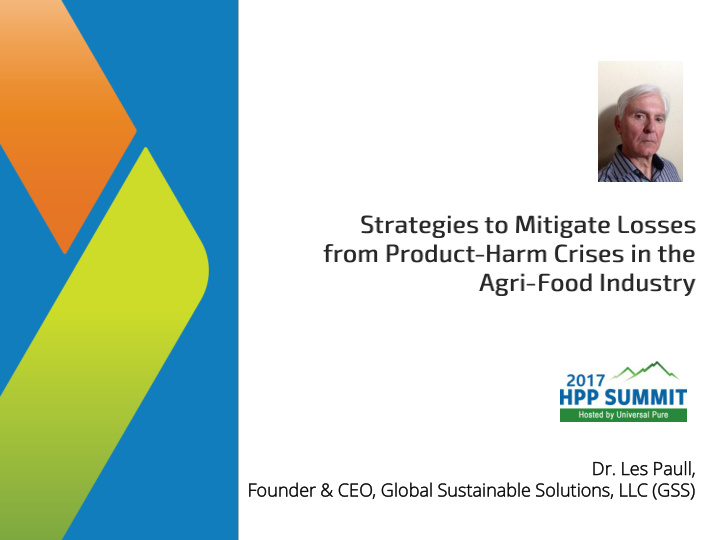



Dr. Les Pau aull, l, Founde der & CEO, Global bal Susta tainable le Solution tions, s, LLC (GSS)
Intelligent Thinking & Strategic Planning Many U.S.-based agri-food companies lack comprehensive strategies to mitigate the effects of a product-harm crisis, which increases the probability of corporate damage to the stock price, brand image, and sustainability. (Cleeren, van Heerde, & DeKimpe, 2013).
Bad Executive Decisions • Product-harm crisis A product-harm crisis is a sudden and unexpected event that threatens to disrupt an organization's operations and poses both a financial and reputational threat (Coombs, 2007). • In June of 2016, the FDA successfully criminally prosecuted executives of the Peanut Company of America for the 2009 product-harm crisis that broke the public trust when salmonella-contaminated peanuts resulted in more than $1 billion in losses and closure of the company (Leighton, 2016).
The Business Problem The lack of corporate strategies to mitigate product-harm crises negatively affects consumer confidence and trust in the Company, Brand, and food safety. GSS provides a top down set of strategies to mitigate the losses associated with a PHC to reduce illness and death to consumers while sustaining brands and corporations from collapse.
Explore Strategies to Mitigate a Crisis • Fear often defines the difference between a great executive and one that is mediocre. • Failure to spend a small amount to provide enhanced food safety usually is based on a fear that increased cost will reduce profit margins and cause customers to switch to another brand. • Executives that explore new ideas and concepts to mitigate a product- harm crisis protect their brand and company sustainability.
Turn Fear to Increased Profits • Current data indicates consumers have a willingness-to-pay (WTP) for increased food safety. • Brand your products with pride to demonstrate the product has increased food safety because you care for consumer well being. • Turn fear to increased profits.
GSS Provides numerous strategies to Mitigate consumer and corporate losses from agri-food product-harm crises Three phases of a crisis Pre-, Mid-, and post Specific strategies for each phase and some overlap • Word-of-Mouth (WOM), Use of Social Media, Spillover Risk • Willingness-to-pay (WTP), Third Party Certifications (TPC) • Brand and corporate sustainability, Capital and personnel deployment
High-Pressure Pasteurization (HPP) An Overarching Mitigating Strategy • Cold pasteurization process • Already sealed packaging • isostatic pressure (300 – 600MPa/43,500-87,000psi) • Pressures above 400 MPa / 58,000 psi at cold (+ 4ºC to 10ºC) or ambient temperature inactivate the vegetative flora (bacteria, virus, yeasts, molds and parasites)
HPP Mitigating Benefits
Pre-crisis Mitigating Strategies- Prepare for the Storm High-pressure pasteurization (HPP) as a strategy to mitigate product-harm crises • Preventative maintenance strategies The use of pre-crisis strategies to mitigate product-harm crises Continuous evaluation of supply chain contamination Traceability- HPP provides a short cut to track a contamination Third-party certifications (TPC) Word-of-mouth communications (WOM) Willingness-to-pay (WTP) Use of Social media
Mid-Crisis Strategies-In the Storm Strategies during the storm of crisis • The use of mid-crisis strategies to mitigate product-harm crises HPP provides users confidence all areas of concern can be quickly checked • Necessary strategies to protect and sustain brand and corporation Spillover liability Word-of-mouth (WOM) communications Use of social media Corporate image management
Post-Crisis Strategies-The Storm has Passed • HPP provides quick access to track a contamination back and manage post-crisis strategies After the crisis has passed • The use of post-crisis strategies to mitigate product-harm crises Sustaining brand attributes Corporate sustainability WOM communications Use of social media Corporate image management
HPP Provides an Overarching Protection The use of high-pressure pasteurization (HPP) Kills pathogens in most fruits and vegetables Provides a barrier to trace back a crisis Reduces tracing time for post-HPP agriculture Users can pass cost for added food safety to consumers under consumer willingness-to-pay (WTP)
Global Sustainable Solutions, LLC Protects Brands, Companies, and Executives • Executives are accountable for a product-harm crisis and may face criminal prosecution. • Failure to obtain and implement adequate strategies to mitigate a product-harm crisis may be deemed negligence. • Proper use of an array of mitigating strategies to reduce losses to consumers and your organization can provide a competitive advantage. • Continue to avoid a crisis, but know what to do when one occurs. • One in 6 Americans is hospitalized with a food-borne illness each year.
Save Lives and Save Your company
Thank You!
Recommend
More recommend